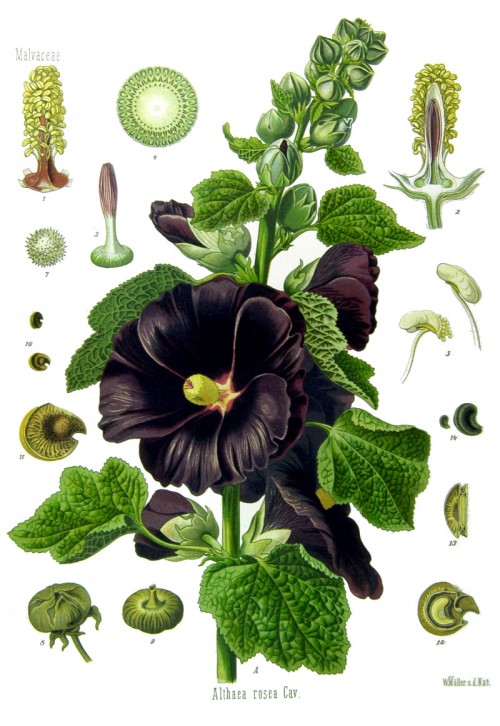Alcea rosea L. - syn.Althaea rosea (L.) Cav.; Althaea rosea var. sinensis (Cav.) S.Y.Hu, Althaea sinensis Cav. - Malvaceae
hollyhock, (Chinesische, Gewöhnliche) Stockrose, Stockmalve, Rosenpappel, Gartenmalve
Strong erect biennial or short-lived perennial herb, mostly unbranched, up to 3m tall, only known in cultivation (Asia, Europe); stem densely hirsute; leaves cordate to orbicular, 5-7 lobed or wavy-angled, 10-30 cm wide, rough, rugose, long-stalked, , crenate; flowers 7cm or more across, nearly sessile, in a long wand-like raceme or spike, many forms and colors (purple, deep purple, black, yellow or white).
„Alcea rosea originated in the SW provinces of China and has been grown in Europe since at least the 15th century. It is cultivated as an ornamental and is used medicinally. It is not known from any truly wild situations.“
http://www.efloras.org/florataxon.aspx?flora_id=2&taxon_id=242302049
„In herbal medicine, Hollyhock is believed to be an emollient and laxative. It is used to control inflammation, to stop bedwetting and as a mouthwash in cases of bleeding gums.“
http://en.wikipedia.org/wiki/Alcea_rosea
„The investigations showed mucilage from flowers of Alcea to be superior to mucilages from leaves or flowers from Malva. High molecular weight acidic polysaccharides (HMWAPs) were isolated from the mucilages of leaves and flowers of both species. The molecular weight of all HMWAPs was in a range of 1.3 to 1.6 x 10(6) D. HMWAP-content in mucilage from flowers of Alcea was highest compared to content in mucilages from leaves or flowers from Malva. HMWAPs were found to be composed mainly of glucuronic acid, galacturonic acid, rhamnose and galactose.“
[High molecular weight acidic polysaccharides from Malva sylvestris and Alcea rosea., Classen, B., Blaschek, W., Planta medica, Vol.64(7), 1998, 640-644]
The dried flowers of A.rosea (Alceae flos, Flores Malvae arboreae) are used in folk medicine to treat inflammation of the upper respiratory-, gastrointestinal- and urinary tract. Used as a gargle in cases of inflammation of mouth and troat, and as a drink to relieve thirst and fever. Anthocyanin content is 0.1-0.2%.
[Hagers Handbuch der Pharmazeutischen Praxis, Springer 2010]
„Nine anthocyanins from Alcea rosea Nigra flowers were characterized as delphinidin 3-O-glucoside (A1), delphinidin 3-O-rutinoside (A2), cyanidin 3-O-glucoside (A3), cyanidin 3-O-rutinoside (A4), petunidin 3-O-glucoside (A5), petunidin 3-O-rhamnosylglucoside (A6), malvidin 3-O-glucoside (A7), malvidin 3-O-rhamnosylglucoside (A8) and malvidin 3-O-malonylglucoside (A9) (Fig. 2). Relative amount of each anthocyanin which was measured by HPLC were 17.1% (A1), 18.1% (A2), 1.2% (A3), 1.5% (A4), 5.3% (A5), 15.3% (A6), 6.4% (A7), 16.5% (A8) and 5.8% (A9), and that of each anthocyanidin was cyanidin (2.7%), delphinidin (35.2%), petunidin (20.6%) and malvidin (26.7%). All anthocyanins are glycosylated at 3-position by glucose or rhamnosylglucose… Thus, it was presumed that black flower color of this cultivar is due to co-occurrence of
many anthocyanins, because the absorption maxima of each anthocyanin is slightly different and anthocyanins are highly accumulated in petals, so that its absorption region spread in all visible range and the petals are visualyzed as black color.“
[Flavonoid Pigments and Color Expression in the Flowers of Black Hollyhock (Alcea rosea Nigra), Hosaka, H., Mizuno, T., Iwashina, T., Bull. Natl. Mus. Nat. Sci., Ser. B, Vol.38(2), 2012, 69–75]
http://www.kahaku.go.jp/research/publication/botany/download/38_2/BNMNS_B3802_069-075.pdf

Köhler, F.E., Medizinal Pflanzen, vol.1, t.19 (1887) [W. Müller]
http://plantgenera.org/species.php?id_species=36588